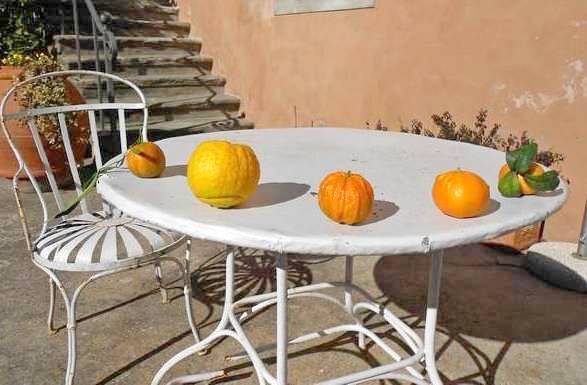Bitter orange (Citrus x aurantium)
[vc_row el_position=”first”][vc_column width=”1/3″][vc_column_text el_position=”first last”]
The bitter orange (Citrus aurantium) tree produces beautiful fruits with a variety of different resemblance; all of them are bitter so they can’t be eaten as they are so are mainly used to produce essential oil or parfume but the easiest way to use them for family need is marmalade.
The bitter orange fruit when boiled with part of external skin produce a lovely marmalade [this will be the topic of a forecaming post]. Seville orange variety is used in the production of marmalade.
[/vc_column_text][/vc_column][vc_column width=”2/3″][vc_single_image image=”4668″ img_size=”full” img_link_target=”_self” el_position=”first last”][/vc_column][/vc_row][vc_row][vc_column][vc_column_text] [/vc_column_text][/vc_column][/vc_row][vc_row][vc_column][vc_separator el_position=”first”][vc_row_inner el_position=”last”][vc_column_inner width=”1/2″][vc_single_image image=”4675″ img_size=”full” img_link_target=”_self” el_position=”first last”][/vc_column_inner][vc_column_inner width=”1/2″][vc_column_text el_position=”first last”]
A cultivar selection from renaissance era
We grow a selection of very few cultivar from the “old” varieties, the same that the Medici family used to made magnificent gardens around Tuscany.
Few year ago we bedded just 6 trees in the same place were originally other orange trees were used to be in the front garden protected by a high wall along the pathway to the stable horse; the next pictures describe the fruit very interseting for their very history coming form very long time ago when no orange was as sweet as the one we’re used to eat right now.
[/vc_column_text][/vc_column_inner][/vc_row_inner][/vc_column][/vc_row][vc_row el_position=”last”][vc_column][vc_separator el_position=”first”][vc_row_inner][vc_column_inner width=”2/3″][vc_column_text el_position=”first last”]
Citrus Aurantium “Cannaliculata“
This cultivar bedded in Tuscany since XVI century, higly ornamental, it’s a fairly vigorous tree with deep green leafs, large and smelly flowers. Its name comes fom the fruit, medium sized with, with deeply furrowed skin.
[/vc_column_text][/vc_column_inner][vc_column_inner width=”1/3″][vc_single_image image=”4654″ img_size=”full” img_link_target=”_self” el_position=”first last”][/vc_column_inner][/vc_row_inner][vc_separator][vc_row_inner][vc_column_inner width=”1/3″][vc_single_image image=”4701″ img_size=”full” img_link_target=”_self” el_position=”first last”][/vc_column_inner][vc_column_inner width=”2/3″][vc_column_text el_position=”first last”]
Citrus Aurantium “Foliis Variegatis“
This bitter orange tree is characterized by the variegated leaves, It is rare to find a tree where the fruit and all the leaves are variegated. As for other cultivar, variegated forms of sour oranges were reported in the gardens of XVIth century Italian villas.
[/vc_column_text][/vc_column_inner][/vc_row_inner][vc_separator][vc_row_inner][vc_column_inner width=”2/3″][vc_column_text el_position=”first last”]
Citrus Aurantium “Corniculata“
An old cultivar known in Italy in the 17th century very likely as the “standard” Citrus Aurantium, with less vigor and slightly assurgent. The cultivar name comes from the small protuberances (only one or more) on the fruit which look like little “horns”. This plant produces abundant fruit, and the ripe fruit is deep orange colour.
[/vc_column_text][/vc_column_inner][vc_column_inner width=”1/3″][vc_single_image image=”4656″ img_size=”full” img_link_target=”_self” el_position=”first last”][/vc_column_inner][/vc_row_inner][vc_separator][vc_row_inner][vc_column_inner width=”1/3″][vc_single_image image=”4655″ img_size=”full” img_link_target=”_self” el_position=”first last”][/vc_column_inner][vc_column_inner width=”2/3″][vc_column_text el_position=”first last”]
Citrus Aurantium “Crispifolia“
Another ancient cultivar bedded in Florence gardens since XVII century, its a small-medium sized tree, charcterized by curled leaf, small fruits depressed on poles
[/vc_column_text][/vc_column_inner][/vc_row_inner][vc_separator][vc_row_inner][vc_column_inner width=”2/3″][vc_column_text el_position=”first last”]
Citrus Aurantium “Salicifolia“
As the name indicates, this is a willow-leafed form of ornamental, vigorous tree cultivated in Italy since XVIII century. The leaves are small, narrow, sharp-pointed, yellowish-green.
[/vc_column_text][/vc_column_inner][vc_column_inner width=”1/3″][vc_single_image image=”4702″ img_size=”full” img_link_target=”_self” el_position=”first last”][/vc_column_inner][/vc_row_inner][vc_separator][vc_row_inner][vc_column_inner width=”1/3″][vc_single_image image=”4657″ img_size=”full” img_link_target=”_self” el_position=”first last”][/vc_column_inner][vc_column_inner width=”2/3″][vc_column_text el_position=”first last”]
Citrus Aurantium “Pompelmo“
This is not part of the old cultivar but the grapefruit or Citrus paradisi, is a very ornamental tree too, so we couldn’t resit from bedding it into our garden and eat its sligtly bitter fruits.
[/vc_column_text][/vc_column_inner][/vc_row_inner][vc_separator][vc_row_inner el_position=”last”][vc_column_inner el_class=”vc_gardening_box” width=”1/2″][vc_column_text el_position=”first last”]
Tip of the day
Villa Castello next to Florence it’s worth a visit just to admire the # 500 and more orange trees in large pottery within one of the most beautiful renaissance garden.
[/vc_column_text][/vc_column_inner][vc_column_inner width=”1/2″][vc_column_text el_position=”first last”]
Conclusion
That’s all! Hope you’ll be a litlle bit more interested in this unusual trees and fruits that really makes the garden more intersting to walk through.
[/vc_column_text][/vc_column_inner][/vc_row_inner][/vc_column][/vc_row]




Comments are closed.